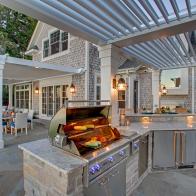1 / 8
Myth: A tight building envelope results in poor indoor air quality.
Reality: Poor indoor air quality (IAQ) is often a result of a leaky house, which allows uncontrolled air to pass through the building envelope. The nonprofit Building Performance Institute, which develops standards for residential energy efficiency retrofits, explains: "Warm, moist conditioned air passes from the living space though the walls on its way outside. When that warm air reaches the cooler temperatures within the wall cavity or inside a window frame, it drops the moisture on condensing surfaces, which can help contribute to mold." Distribution of carbon monoxide from an attached garage into the home is another consequence of a leaky home, according to the American Lung Association.
As part of a building performance evaluation (or energy audit), a certified contractor uses a blower door to depressurize the home and locate air migration pathways that need to be sealed. The cost of an evaluation ranges from $250 to $500, a fee some municipalities subsidize through the Energy Star program.
Reality: Poor indoor air quality (IAQ) is often a result of a leaky house, which allows uncontrolled air to pass through the building envelope. The nonprofit Building Performance Institute, which develops standards for residential energy efficiency retrofits, explains: "Warm, moist conditioned air passes from the living space though the walls on its way outside. When that warm air reaches the cooler temperatures within the wall cavity or inside a window frame, it drops the moisture on condensing surfaces, which can help contribute to mold." Distribution of carbon monoxide from an attached garage into the home is another consequence of a leaky home, according to the American Lung Association.
As part of a building performance evaluation (or energy audit), a certified contractor uses a blower door to depressurize the home and locate air migration pathways that need to be sealed. The cost of an evaluation ranges from $250 to $500, a fee some municipalities subsidize through the Energy Star program.
.-Battle-on-the-Beach-courtesy-of-HGTV.-.jpg.rend.hgtvcom.196.196.suffix/1714847929029.jpeg)







